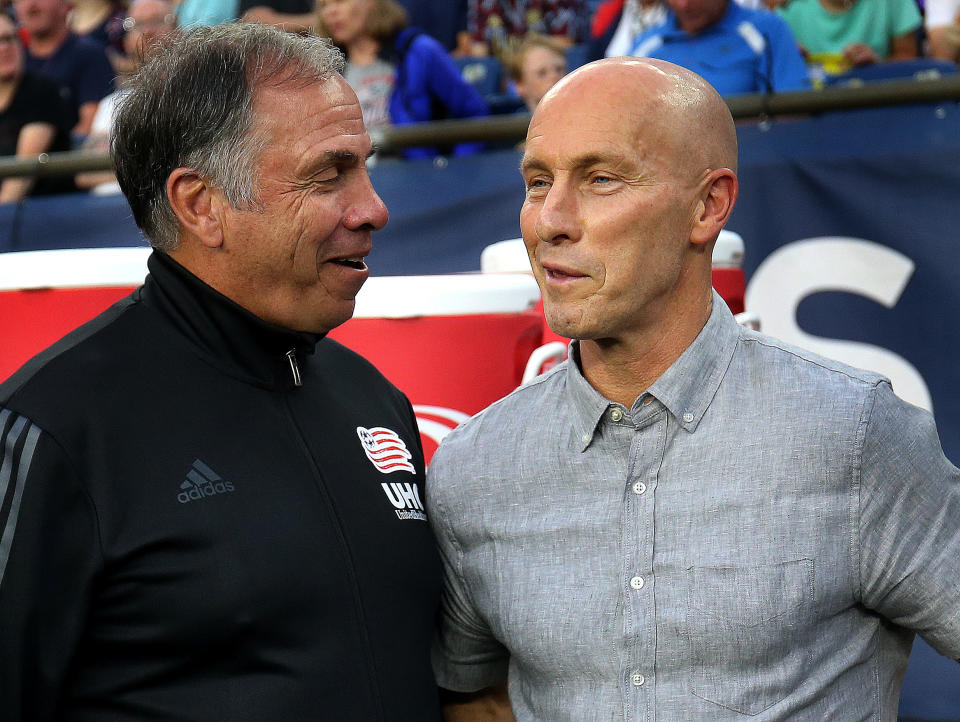On covering soccer in the 2010s, when the sport's growth in America truly took hold
I didn’t set out to write about American soccer. I certainly didn’t try to cover it for the last decade. Still, Jan. 4 marks my 10-year anniversary writing about the sport stateside. That was the day I started at ESPN.com as its first full-time soccer writer.
It was all quite by accident.
My future wife and I had returned to the United States after living in Brussels for two years, where I’d worked as a foreign correspondent for two American outlets, covering NATO and the EU institutions, and wrote for a local expat magazine, profiling anyone from the prime minister to the world’s foremost Elvis impersonator. On the side, I’d written the Guardian’s Dutch soccer column for its website for a season. I didn’t think much of it. Surely that wasn’t a career prospect once we moved to Washington, DC.
So I was looking for a job in journalism. Any job. Anything at all. And I got rejected for just about all of them. I got rejected for jobs I emphatically didn’t want. I got turned down for some bad jobs. No, actually, that isn’t quite right. I didn’t even hear back from them, my applications tumbling into a black hole, as if they’d never even happened.
And then I did get a job.

ESPN was investing heavily in the 2010 World Cup, making it a centerpiece of its corporate strategy. It would be sending some two dozen reporters and editors, to go along with several hundred TV people. I’d gotten in touch with an editor at ESPN before we’d moved. He didn’t have a job for me then. Or even any money in his freelance budget. And then, out of nowhere, I was hired – even though I hadn’t even been told that there was a job open until the morning of a long day spent interviewing with about 10 people, most of whom I’d never see again.
Just like that, I was a soccer writer. At the time, only half a dozen or so full-time jobs covering soccer existed in America. It was an impossible stroke of luck. There were scores of others just as qualified as I was, if not more so. I had been to one U.S. men’s national team game in my entire life – the day the Yanks clinched their spot at the World Cup in South Africa, hours after a horrific car crash had nearly killed Charlie Davies – and one Major League Soccer game. A U.S. Open Cup game between MLS teams, actually.
Within weeks, I was dispatched to the national team’s traditional January camp in Los Angeles, spending more than a week getting the know players who would hardly feature thereafter – Matt Pickens! Justin Braun! Sam Cronin! Ugo Ihemelu! – and watching a 3-1 friendly loss to Honduras in which Jimmy Conrad was sent off with a second yellow in the 17th minute, his 27th and final cap.
But if it took a while to learn the vast senior national team player pool, understanding some of the issues in the American game was easier.
It’s entirely possible that the day I learned the most about American soccer was coaching my first American Youth Soccer Organization game. The local chapter was looking for volunteers. So I’d signed on as an assistant to a lovely, middle-aged lawyer who eagerly coached his son’s under-14 team but openly admitted that he didn’t know a whole lot about soccer. I’d never coached, but at least I knew the game. Our team was competitive and the kids seemed to have fun. It was a good experience.
The revelation came when I overheard the opposing coach tell his own assistant that he didn’t want to put a certain player in because “we already have too many left-footers on the field.” That’s when it dawned on me that he had no idea what he was doing either. That nobody did. And that while this was hardly the elite youth soccer track, the structural lack of knowledge at the youth level ran much deeper than I’d imagined.
This may have been an anecdotal bit of evidence, but if the teenagers were getting this kind of non-coaching, the all-important under-8 and under-10 and under-12 age groups presumably were as well, and on a massive scale. Because it stands to reason that the kinds of parents who sign up to coach these teams are the most eager and knowledgeable of the bunch. And, well, their knowledge was practically nil. This was true across the entire league. The grassroots aren’t really grass or roots so much as a few seedlings in a dry, barren field.

But somewhere along the way, on the journey from ESPN to FOX Sports to Yahoo Sports, my working home of the last five years, and covering three World Cup cycles and a handful of MLS Cups, I fell deeply in love with the American game. While reporting on four different men’s national team head coaches and three women’s ones – the taciturn Bob Bradley, the cheerful but ineffectual Jurgen Klinsmann, the no-nonsense Bruce Arena, the studious Gregg Berhalter, the charismatic Pia Sundhage, the measured Tom Sermanni, and the unruffled Jill Ellis – I watched two programs bound forward in their relevance and professionalism, even if the results didn’t always sync up neatly.
Meantime, MLS went from a league that had only recently staved off its own demise to one collecting a jaw-dropping $325 million expansion fee in North Carolina, all the while building fan bases and one gleaming stadium after another and growing out of its reliance on aging superstars for market traction.
That’s what makes covering American soccer so much fun – aside from the access to journalists, which is unrivaled in any other established football culture. The possibilities aren’t yet exhausted. After two decades of staggering growth, it feels like we’re still a long way from the outer bounds, like there’s plenty of room left to get bigger. Nobody has presented a compelling argument for why soccer can’t be as big here as football, or basketball, or baseball – assuming it isn’t bigger than baseball already, when you consider the attention paid here, by all sorts of Americans, to the entirety of the world’s game.
Because that’s the thing. Tastes in sport change all the time. In the 19th century, horse racing was the top sport in America. Then it was boxing. And baseball. Football came next, threatened for a while by basketball. Sports rise and fall. Remember when NASCAR was the new thing? Or poker?
Unlike some of the other mainstream sports (because soccer is very much that now, even it never had the exact and much speculated-upon moment when it arrived), it feels like soccer isn’t maxed out yet. There are more fans to be won, more markets to be built up, many more gains to be made on the field, relative to the global competition.
Witnessing that progression, on the biggest stage at the World Cup or a smaller one in the college or youth games or some of the lower leagues, is what has made this job so much fun. It’s not always the same teams, in the same leagues, performing in the same more-or-less fixed band of results. It’s constantly changing, evolving. And as such, the job was never the same.
It’s that potential and the flux that made me fall in love with covering American soccer.
And I got to write a lot of stories that I’m still proud of.
This decade has been a blast. I hope I get another one.
Leander Schaerlaeckens is a Yahoo Sports soccer columnist and a sports communication lecturer at Marist College. Follow him on Twitter @LeanderAlphabet.
More from Yahoo Soccer’s Best of 2010s

